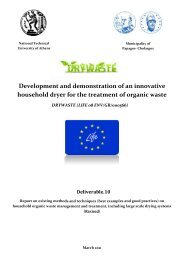MOROCOMP (LIFE TCY05/MA000141) - Unit of Environmental ...
MOROCOMP (LIFE TCY05/MA000141) - Unit of Environmental ...
MOROCOMP (LIFE TCY05/MA000141) - Unit of Environmental ...
You also want an ePaper? Increase the reach of your titles
YUMPU automatically turns print PDFs into web optimized ePapers that Google loves.
carbon for each part <strong>of</strong> nitrogen by weight, although ratios from 20:1 up to 40:1 can<br />
give good composting results [24, 25, 37, 38]. Low ratios supply the mixture with<br />
excess <strong>of</strong> nitrogen which is lost as ammonia gas 6 creating undesirable odors whereas<br />
high C:N ratios cause shortage <strong>of</strong> nitrogen and the degradation rate <strong>of</strong> the composting<br />
material remains relatively low since micro-organisms must go through many lifecycles,<br />
oxidizing <strong>of</strong>f the excess carbon until a more convenient C:N ratio for their<br />
metabolism is reached. In addition nitrogen limitation may lead to extensive organic<br />
acid formation from carbonaceous waste, which tends to lower the pH and thereby<br />
retard the microbial activity. The ratio is weighted in favor <strong>of</strong> carbon, because uses for<br />
carbon outnumber those for nitrogen in microbial metabolism and synthesis <strong>of</strong><br />
cellular materials. Not only is carbon utilized in cell wall or membrane formation,<br />
protoplasm, and storage products synthesis but also an appreciable amount is also<br />
oxidized to CO 2 in metabolic activities. On the other hand, nitrogen has only one<br />
major use as a nutrient namely as an essential constituent <strong>of</strong> protoplasm.<br />
Consequently, much more carbon than nitrogen is required. Figure 10 presents the<br />
carbon nitrogen ratio evolution during the 1 st composting trial.<br />
[C/N]<br />
18<br />
16<br />
14<br />
12<br />
10<br />
8<br />
1 3 5 7 9 11 13 15 17 19 21 23 25 27 29<br />
Days<br />
Figure 10: Changes in C:N ratio during the 1 st composting trial<br />
According to Figure 10 during the 1 st composting trial, the C:N ratio presents a<br />
steadily downwards inclination. This inclination can be explained by the carbon loss<br />
6 leads to excess ammonia formation, which increases the pH and thereby enhances ammonia<br />
volatilization<br />
46










